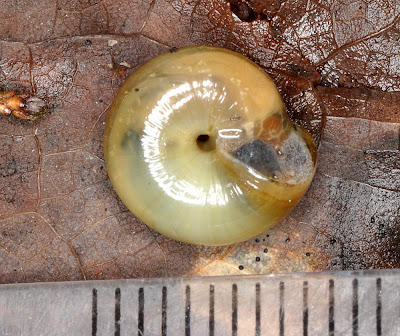I did quite a bit of snailing over the Easter weekend. I am fortunate enough that my home in Dallas, PA is not far from plenty of really great habitat. But, more specifically, I am close to the great old growth forest of Ricketts Glen State Park. As such, I managed to steal a couple hours both Saturday and Sunday to do a little snailing and birding at the glen.
The first day I really only worked a small patch where the road and the creek combine. While there was 'shit for birds' as I say when there isn't much bird action, there was certainly no lack of terrestrial mollusks.
One snail that I only found in one spot, but 6 individuals, was Euchemotrema fraternum. I interestingly read a couple days ago a reference by F. Wayne Grimm that this is actually a species complex as he wrote
here about the species in Ontario.
Euchemotrema fraternum (Say, 1824) - A complex of at least three distinct forms, represented by pure populations and probable hybrids. As there are anatomical, distributional, and habitat differences, it is unwise to subsume them under "fraternum" and look the other way, hoping that a fascinating evolutionary problem will evaporate, leaving identifications simple. In the U.S. known from Minnesota, Iowa, and Missouri eastward across the Great Lakes Basin to Alabama, North Carolina, and New England (Hubricht, 1985). In Ontario, found frequently in mesic forest situations from Algoma and Temagami southward (Oughton, 1948: 9). Breeding experiments and comprehensive anatomical comparisons are to be undertaken when resources and time permit.
They were all under bark that was laying on the ground within 15 feet of the creek. Alongside them were a couple Discus catskillensis and a immature Polygyrid.
I'm not sure why I didn't take apertural and umbilical views of any of the Discus catskillensis I found, but here is an apical view.
Another snail I found quite a bit of is Triodopsis tridentata. It's probably the polygyrid I find most in my county.
One interesting individual looks as if he had to overcome some traumatic experience as you can see by the deformity of his body whorl getting close to the aperture and some breaklines:
Another snail I found a couple of is Anguispira alternata. The 'Flaming Tigersnails' that I've noted in the park are definitely not that flaming and instead rather dull compared to a some I've seen as far as the shell goes. But their bodies are very varied with purples and pinks.
I really didn't see many empty shells but had one that struck my fancy:
I haven't had a chance to work a key for it but I'm leaning towards Xolotrema denotatum. However, the ones I've seen in the park are thicker than this shell. I'll have to revisit these photos at a later date but compare to below... pretty much the same except thickness. Plus this guy is light colored. Some I've seen are dark, hence the name Velvet Wedge.
The next day I found some different species, as well as had some new birds for my year. I had a singing Veery, which seems like it might be a week or so early but I'm terrible with dates and it could be spot on. Also the forest had my first of year Ruby-crowned Kinglets and Blue-headed Vireos.
Speaking of Xolotrema denotatum, I think here's one that seems to have lost his velvety periostracum that gives them the common name, Velvet Wedge:
I only found 2 introduced species, a single Arion subfuscus and a yellow Arion slug. I've seen a couple of these all yellow Arions in the park but am not sure which species it is. The one I found Sunday was immature and crawling on a log right next to a Philomycus flexuolaris.
Almost forgot, on Saturday I also found what I believe are of the Mesomphix genus, maybe Mesomphix perlaevis or inornatus, but I don't have a field microscope to check on the microsculpture, as it's my understanding you can differentiate the two species I mentioned by the presence or absence of minute papillae (
see here):
Another snail of interest, this one from Sunday, was a 9mm Ventridens species that I haven't looked at a key to see if I can identify from my photos. But this little guy was just walking around on the leaf litter near one of the falls. Of course he tucked in the second I leaned down to photograph him. But I'd hide too if something way bigger than me was checking me out.
And the flowers were out:
And some mushrooms :
And one last cool thing I saw over the weekend, although this was at Moon Lake State Park which I just went birding and only lifted a couple rocks, finding this creature: a Smooth Green Snake (Liochlorophis vernalis), the first one I've ever seen. But I'm not a herp guy.
WAIT!! How could I forget about the snail I was most excited to find? At least, I'm reasonably sure of identification, I found 3 Haplotrema concavum in various places, but 2 were in close quarters with an Anguispira alternata and Triodopsis tridentata. For those that don't know, Haplotrema concavum is a snail-eating snail, a real killer. These were at Ricketts.
All very cool stuff! How the hell can anyone be bored when there's this much out there? And I'm only scratching the surface...



















































